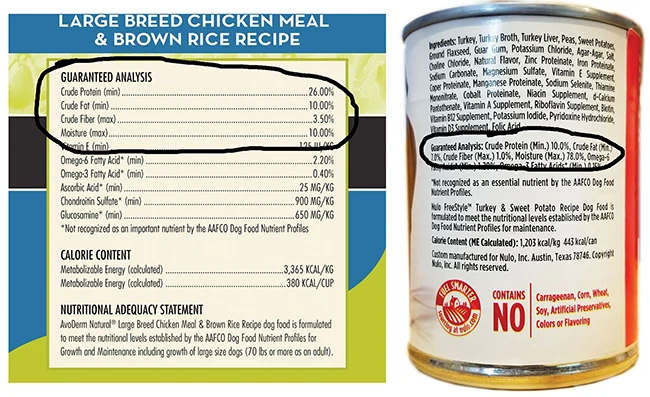
Taking care of our pets means ensuring they get the best nutrition possible. But with so many dog food options available, figuring out what’s best can feel overwhelming.
With all the different brands and their claims, it’s easy to get confused about what to choose. Our easy-to-read quick guide can help you understand dog food labels so you can feel confident picking the best food for your pup’s health.
Key Components of a Dog Food Label
Dog food labels contain essential information that can help you determine the quality and suitability of the food for your pet. Key components you need to look for on dog food labels include:
- Product Name
The product name might seem like a simple detail, but it can reveal a lot about what’s inside the bag or can. According to the Association of American Feed Control Officials (AAFCO), specific rules govern how ingredients are represented in the name.
For instance, if the label says “Beef Dog Food,” at least 95% of the product must be beef, not counting added water for processing. But if it says “Beef Dinner for Dogs,” the beef content only needs 25% or more of the total product.
Watch out for misleading marketing terms like “with beef” or “beef flavor.” The “with” rule means the advertised ingredient must make up only 3% of the product, while “flavor” doesn’t require any specific amount – just enough to appeal to dogs. These labels are designed to catch your eye but don’t necessarily mean the food is packed with the highlighted ingredient.
- Ingredient List
Ingredients are listed in descending order by weight, so the first few items are the most abundant in the formula.
Look for high-quality protein sources like real meat, fish or poultry near the top of the list. For example, wild-caught salmon dog food ensures high-quality salmon ingredients, providing essential nutrients and omega-3 fatty acids that promote a healthy coat and skin.
However, be wary of excessive fillers like corn, wheat or soy and artificial additives listed further down. While ingredients like “meat meal” may sound unappetizing, they can be a concentrated protein source from animal tissues and by-products. As long as too many fillers do not accompany them, they can be an acceptable ingredient.
- Guaranteed Analysis
This section outlines the minimum percentages of crude fat and protein, as well as the maximum percentages of moisture and crude fiber. These numbers can help you evaluate whether the formula meets your pup’s specific nutritional needs based on their age, activity level and overall health.
For example, a high-energy working dog may require food with higher protein and fat levels, while a sedentary senior may benefit from lower levels to support their metabolism.
- Nutritional Adequacy Statement
The nutritional adequacy statement is your reassurance that the dog food meets specific nutritional standards set by the AAFCO. This statement will also indicate which life stage the formula is suitable for, such as puppy, adult or senior.
If your pet has any special dietary requirements, cross-check this detail. For instance, a food labeled “all life stages” may be inappropriate for a growing puppy or a senior dog with specific nutritional needs.
- Feeding Guidelines
The feeding guidelines provide a helpful starting point for determining how much to feed your dog based on their weight and age. However, your pup’s needs may vary based on activity level, metabolism and overall health. It’s always best to consult with your veterinarian to determine the ideal portion sizes, especially if your dog is prone to weight gain or loss.
Decoding Marketing Claims
Dog food labels are plastered with buzzwords and claims, leaving many pet parents overwhelmed and unsure of what it all means. Here are some common ones:
- Organic. This term refers to products made without synthetic pesticides, fertilizers or genetically modified organisms (GMOs). Organic dog foods must meet the same standards as organic human foods set by the USDA’s National Organic Program. This also includes limitations on artificial preservatives, colors and flavors.
- Grain-free: While popular, there’s no definitive evidence that grain-free diets benefit most dogs more than a standard canine diet.
- Holistic. This vague term generally implies a focus on whole, natural ingredients, but it lacks a clear definition or regulation.
- Human-grade. For dog food to be truly human-grade, all ingredients must meet the same standards as human-edible foods and the product must be manufactured and handled according to FDA regulations for human food.
- Novel proteins. These refer to less common protein sources like bison, kangaroo or rabbit. They may be suitable options for dogs with allergies or sensitivities to more traditional proteins like chicken or beef.
Give Your Pet the Best Nutrition Possible
Always prioritize high-quality, easily recognizable ingredients and consult your veterinarian to ensure you meet your pup’s nutritional needs. Whether you opt for traditional kibble, a freeze dried raw dog food or delicious wet food, the key is choosing based on facts, not marketing gimmicks.



